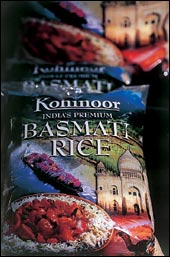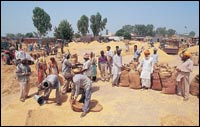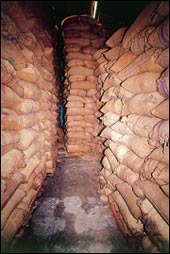


 The Harvest of Kohinoor Basma Chawa
The Harvest of Kohinoor Basma Chawa
Forget Dehradun, the finest Basmati rice is grown in Amritsar. Lush green fields sway in the breeze with long-grained stems of the prestigious rice. Amd in grannaries, many hands make light work of the harvest as they pack the Kohinoor Basmati Rice that goes into cooking pots all over India, discovers UpperCrust. |
|
Basmati is a generic name. It is the name of the rice that is produced in Indian and Pakistani Punjab. "Sow this grain in any other region like, say, the rice-producing areas of South India, and the fragrance and taste vanishes," says Navin. "Only Punjab's soil gives the rice this unique distinction. It is to do with the weather and soil conditions of North India. And the fact that the rice is grown in the foothills of the Himalayas." Now Basmati seeds are cultivated mainly in Amritsar district, and also in Gurudspur and some areas of Ludhiana.
So much for Basmati. Now for Satnam Overseas Limited. It is the star trading house in the country for rice and has been in the business since 1979 only. This is a family business run by three brothers, Jugalkishore, Satnam and Gurnam, who's nephew Navin is. Earlier, the family was a commission agent in the grain market. They started their own rice mill in 1979 for the production of Basmati and non-Basmati rice from Punjab. The first year, Satnam Overseas Limited produced three grains of rice: a Basmati, Parmal 106 and IR-8. By 1980, they were already exporting PR-106 to Dubai, and then they got an order to ship three containers of Basmati to Canada. Then the USA followed. Any by 1982, they had the Middle East market as well in their order books.
Satnam Overseas Limited has its mother plant in Bhagtanwala area of Amritsar, opposite the biggest grain market in Punjab. This, unfortunately, was the area chosen by the Khalistani terrorists as their very own. Hindu and Sikh industrialists were targetted for ransom by the terrorists. Some paid, some were killed, some ran away and shifted base elsewhere. "We went to Delhi in 1986 and by 1990, we set up a rice mill in Sonepat, which is in Murthal on the Grand Trunk Road. I was already in Delhi with Gurnam looking after the office there. Satnam and then Jugalkishore joined us," says Navin. "When they all came to Delhi, I shifted to Amritsar and took over the business here. We had security, a CRPF company of 120, in pickets all over the rice mill." He points out to me the pickets that are still in place, but which, today, don't even have a watchman in them. Amritsar is now one of the safest, happiest cities of the country.
He doesn't compare Pakistan's Basmati rice favourably to Indian at all. "Theirs is inferior in quality." Navin says. "It is also inferior in length and aroma. They have a Colonel brand Basmati which matches Indian Basmati somewhat, but lacks length, aroma and fragrance. They don't have the Dehradun grain but are now working on long-grain seeds. The nutritional value of such grains is high." And Kohinoor... the brand that has over 40 per cent of the Indian market share, and which is distributed in every state and every major city through a wide network, is now available in new packaging. It is being advertised in mainstream India and in regional areas as well. The Nawab of Pataudi, Mansur Ali Khan, and his beautiful wife, Begum Sharmila Tagore, do some of the ads. You may have seen them.
Finally Navin says, "The rice that the consumer gets is at least one year old. We store it to get the best cooking results out of the grain. It gets hard and dry. It loses some aroma, but it cooks better. The paddy is dried up to 13 per cent of its moisture, it is dehusked, then polished to remove the bran, and packed in machinery that comes from Japan, Canada and UK. And also, the grain doesn't break easily when the rice is stored for a year. New rice, the grain is soft and breaks. In Basmati rice, we try to save the corners to the maximum content. The grain is fragile but the machine yet does a perfect job. Because it is the corners that give the rice grain its length, its aroma and fragrance. That's why when women are buying rice in a grain shop, they pick up a fistful of grain, break off the corners, then smell it!"
|

Home Page
About the mag
Subscribe
Advertise
Contact Us
 He would know. Satnam has been in the Basmati business for long. He shares more Basmati information. Haryana is the biggest producer only because there is more production area in the state, he says. Otherwise, the best Basmati grains are grown in Punjab. There is a difference in quality between the Hayrana Basmati rice and Punjab's. The Punjab variety has better fragrance and taste. The Haryana Basmati is a drier kind, the grains retain lesser water; as a result, they are thicker when cooked. And the taste, naturally, is lesser!
He would know. Satnam has been in the Basmati business for long. He shares more Basmati information. Haryana is the biggest producer only because there is more production area in the state, he says. Otherwise, the best Basmati grains are grown in Punjab. There is a difference in quality between the Hayrana Basmati rice and Punjab's. The Punjab variety has better fragrance and taste. The Haryana Basmati is a drier kind, the grains retain lesser water; as a result, they are thicker when cooked. And the taste, naturally, is lesser!
 The crop is harvested in November. The seeds are sowed in June and July. It takes four to six months to have green, swaying paddy fields full of Basmati rice in Amritsar. This particular grain does not require much rainfall. Three to four showers are enough. What Basmati needs to really grow well is morning dew. And in Amritsar, it is the winter dew that really nourishes the crop. "The Punjab dew is the main reason why Basmati rice grown here is so aromatic and fragrant," says Navin. Thankfully, the state has a long winter. The seaon begins early, at the end of September some years, and it continues till late Fenruary. No wonder Punjab is King of Basmati production!
The crop is harvested in November. The seeds are sowed in June and July. It takes four to six months to have green, swaying paddy fields full of Basmati rice in Amritsar. This particular grain does not require much rainfall. Three to four showers are enough. What Basmati needs to really grow well is morning dew. And in Amritsar, it is the winter dew that really nourishes the crop. "The Punjab dew is the main reason why Basmati rice grown here is so aromatic and fragrant," says Navin. Thankfully, the state has a long winter. The seaon begins early, at the end of September some years, and it continues till late Fenruary. No wonder Punjab is King of Basmati production!
 "Earlier," explains Navin, "exports orders were handled exclusively by exporters from Bombay. We became the first producers to directly export Basmati rice abroad." In 1984-85, Satnam Overseas Limited bagged the UK market as well. "And now, we are all over the world," says Navin gleefully. Indeed, they are. All the rice they produce gets exported, but Basmati goes mainly to the US, UK and Middle East. And a small quantity to markets in Australia, some nations of South-East Asia and Europe.
"Earlier," explains Navin, "exports orders were handled exclusively by exporters from Bombay. We became the first producers to directly export Basmati rice abroad." In 1984-85, Satnam Overseas Limited bagged the UK market as well. "And now, we are all over the world," says Navin gleefully. Indeed, they are. All the rice they produce gets exported, but Basmati goes mainly to the US, UK and Middle East. And a small quantity to markets in Australia, some nations of South-East Asia and Europe.
 Satnam Overseas Limited, which became a public limited company in 1992, today produces several brands of Basmati rice. These include Shahenshah, Rose, Charminar, Trophy... Navin says, "There is big difference in all of them. In purity, length, quality. Everybody cannot afford Kohinoor. The other brands are for the middle classes." They don't have rice fields of their own ("There is no fun in that," says Navin mysteriously!), but for a small five acre plot in the mill area that is used for experimental purposes. They sow the best seeds here and then distribute the same to farmers from whom they buy paddy. That way they are ensured of the best quality grains. Their paddy suppliers are farmers who have fields all around the mill, which is really border area, and close to Pakistan.
Satnam Overseas Limited, which became a public limited company in 1992, today produces several brands of Basmati rice. These include Shahenshah, Rose, Charminar, Trophy... Navin says, "There is big difference in all of them. In purity, length, quality. Everybody cannot afford Kohinoor. The other brands are for the middle classes." They don't have rice fields of their own ("There is no fun in that," says Navin mysteriously!), but for a small five acre plot in the mill area that is used for experimental purposes. They sow the best seeds here and then distribute the same to farmers from whom they buy paddy. That way they are ensured of the best quality grains. Their paddy suppliers are farmers who have fields all around the mill, which is really border area, and close to Pakistan.